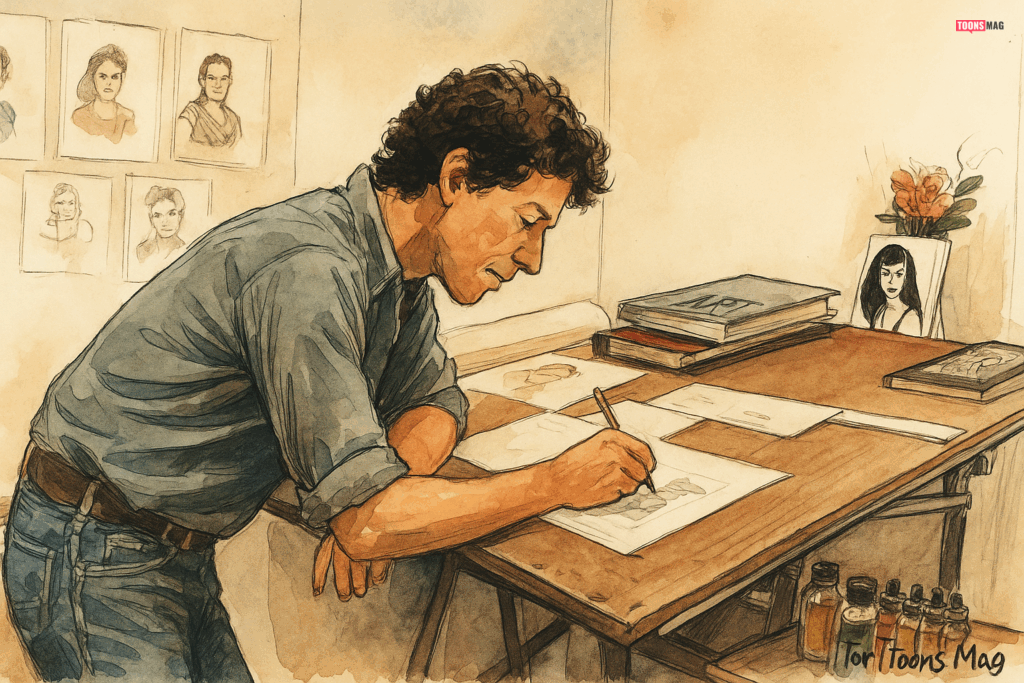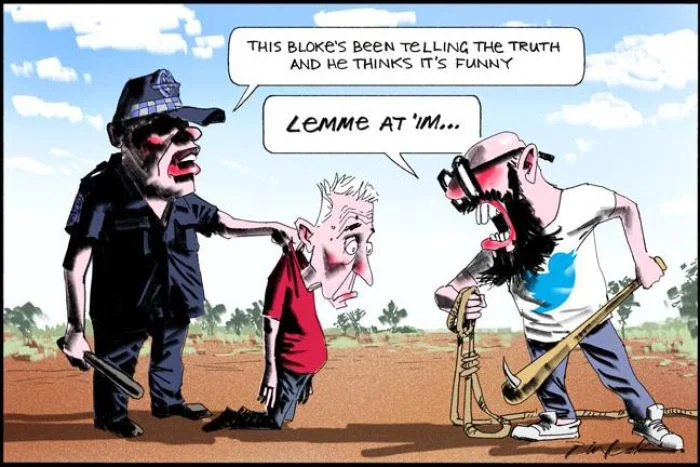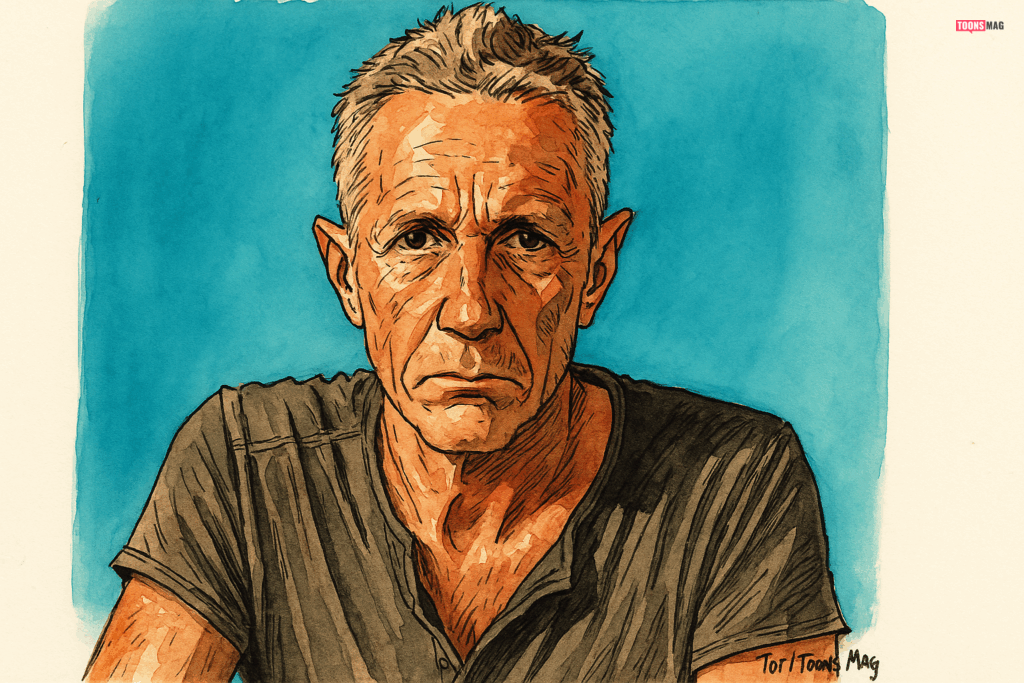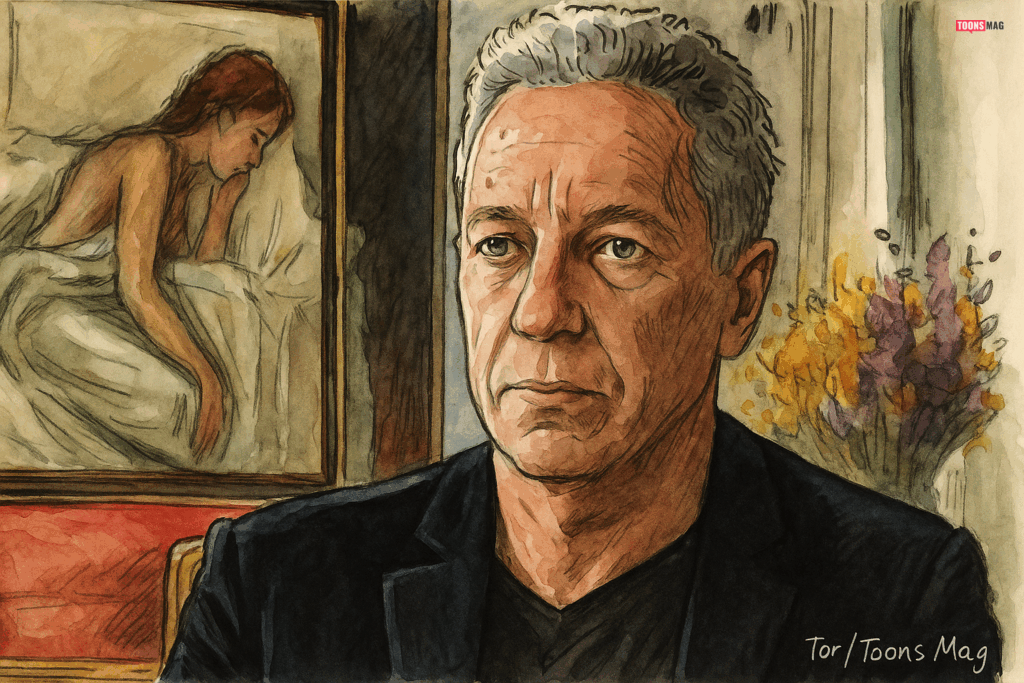Desmond Robert “Bill” Leak (9 January 1956 – 10 March 2017) was a leading Australian editorial cartoonist, caricaturist, and portraitist. Revered for his technical artistry and feared for his confrontational wit, Leak shaped the national conversation for more than three decades through his biting cartoons, rich oil portraits, and fearless social commentary. A nine-time Walkley Award winner and regular Archibald Prize contender, he became one of the most polarizing yet essential voices in Australian visual journalism. Through his cartoons and paintings, he dissected the nation’s politics, culture, and media, often with a scalpel-like precision that invited both praise and outrage.
Infobox: Bill Leak
| Name | Desmond Robert “Bill” Leak |
|---|---|
| Born | 9 January 1956, Adelaide, South Australia, Australia |
| Died | 10 March 2017 (aged 61), Gosford, NSW, Australia |
| Occupation | Cartoonist, Caricaturist, Portraitist, Novelist, TV Presenter |
| Partner | Lo Mong Lau |
| Children | Johannes Leak, Jasper Leak |
| Years Active | 1983–2017 |
| Known For | Editorial cartoons in The Australian, Archibald Prize portraits |
| Education | Julian Ashton Art School (incomplete) |
| Awards | 9 Walkley Awards, 20 Stanley Awards, 2 News Corp Awards |
| Books | Heart Cancer, Drawing Blood, Trigger Warning, etc. |
| TV | Face Painting (2008, ABC TV) |
Early Life and Career Beginnings
Born in Adelaide in 1956 into a working-class Labor-voting family, Bill Leak grew up in Condobolin before relocating to Beacon Hill in Sydney. From an early age, Leak demonstrated a strong inclination toward drawing, often sketching imaginary scenes and humorous characters in his school notebooks. His early environment, though lacking in formal cultural resources, was a creative playground for his imagination. He described Beacon Hill as “intellectually barren,” a place where artistic pursuits were often misunderstood or undervalued. This cultural vacuum, however, inspired Leak to develop a strong inner world through his art, cultivating a rebellious and reflective streak that would later define his career.

While still in high school, Leak began sketching satirical portraits of his teachers—a provocative act that led to disciplinary action and a transfer from Beacon Hill High to Forest High School. His classmates and some faculty members recognized his talent, even if they didn’t always appreciate the subjects of his satire. These formative years marked the birth of his identity as a satirist and social critic, a role he would embrace for the rest of his life.
After high school, Leak enrolled at the Julian Ashton Art School, one of Australia’s most prestigious art institutions. He studied there for two years, receiving classical instruction in drawing and painting. Though he did not complete the full course, the exposure to life drawing, anatomy, and composition had a lasting impact. He later credited the school with providing him the technical discipline that would underpin both his cartoons and his fine art.
In the late 1970s, hungry for inspiration, Leak embarked on an extended trip to Europe—a rite of passage for many young artists. He married a German woman named Astrid and settled in Bavaria, where he immersed himself in the continent’s rich artistic traditions. The couple frequented museums and galleries, and Leak filled dozens of sketchbooks during his travels. A pivotal moment came in 1978 when he attended a Paul Cézanne exhibition at the Grand Palais in Paris. He later recalled being overwhelmed by Cézanne’s brushwork, color theory, and ability to capture emotional depth in form. That exhibition fundamentally shifted Leak’s understanding of painting and ignited his ambition to be more than just a cartoonist.
During his years in Europe, Leak also began experimenting with oil painting, portraiture, and visual storytelling. He took part in informal workshops, exchanged ideas with other artists, and even explored surrealism and modernism before returning to his realist roots. Returning to Australia in 1982, he brought with him not only a broadened artistic vision but also the seeds of the unique visual language that would define his future work. He and Astrid divorced shortly after their return, but the experience left a deep imprint on Leak’s style and ambition, setting the stage for the next transformative chapter in his life.
Rise in Cartooning and News Limited Career
Leak’s professional cartooning career began in 1983 with contributions to The Bulletin, followed by The Sydney Morning Herald. By 1994, he had moved to The Daily Telegraph-Mirror and soon after, to The Australian, where his voice became a mainstay of conservative editorial opinion.
At The Australian, Leak became known for his fearless depictions of politicians, activists, and public figures. His art skewered hypocrisy on all sides of politics, though critics often accused him of punching down. Leak insisted that satire should spare no one in power and that cartooning’s role was to provoke, not appease.
Some of his most controversial works included:
- 2006: A cartoon mocking Indonesia’s reaction to West Papuan refugees, seen by many as racially insensitive.
- 2007: A Tintin parody featuring Kevin Rudd, which led to a copyright dispute.
- 2015: A cartoon of Indian villagers attempting to eat solar panels, criticized as racist but later defended by the Press Council.
- 2016: An Aboriginal parenting cartoon published on National Aboriginal and Torres Strait Islander Children’s Day that sparked national debate.
- 2016: His “Waffen-SSM” cartoon, comparing same-sex marriage activists to Nazi stormtroopers, which drew sharp condemnation from LGBTQ+ advocates and Jewish community leaders.
While often condemned, these works also gained him staunch defenders who praised his commitment to free speech and refusal to censor difficult truths. Leak saw political correctness as a danger to democracy, and his cartoons were his battleground.
Rise in Cartooning and News Limited Career
Leak’s professional cartooning career began in 1983 with contributions to The Bulletin, followed by The Sydney Morning Herald. By 1994, he had moved to The Daily Telegraph-Mirror and soon after, to The Australian, where his voice became a mainstay of conservative editorial opinion.

At The Australian, Leak became known for his fearless depictions of politicians, activists, and public figures. His art skewered hypocrisy on all sides of politics, though critics often accused him of punching down. Leak insisted that satire should spare no one in power and that cartooning’s role was to provoke, not appease.
Some of his most controversial works included:
- 2006: A cartoon mocking Indonesia’s reaction to West Papuan refugees, seen by many as racially insensitive.
- 2007: A Tintin parody featuring Kevin Rudd, which led to a copyright dispute.
- 2015: A cartoon of Indian villagers attempting to eat solar panels, criticized as racist but later defended by the Press Council.
- 2016: An Aboriginal parenting cartoon published on National Aboriginal and Torres Strait Islander Children’s Day that sparked national debate.
- 2016: His “Waffen-SSM” cartoon, comparing same-sex marriage activists to Nazi stormtroopers, which drew sharp condemnation from LGBTQ+ advocates and Jewish community leaders.
While often condemned, these works also gained him staunch defenders who praised his commitment to free speech and refusal to censor difficult truths. Leak saw political correctness as a danger to democracy, and his cartoons were his battleground.
News Limited career
Cartoon
The Leak began drawing cartoons professionally in 1983, first for The Bulletin and then for The Sydney Morning Herald. Leak resigned from The Sydney Morning Herald to take up a role at The Daily Telegraph-Mirror, News Limited newspaper, in 1994. He later moved to The Australian (also News Limited newspaper).
In April 2006, Leak drew a cartoon captioned “No Offence Intended”, depicting an Indonesian person resembling then president, Susilo Bambang Yudhoyono, as a dog mounting a Papuan native. The drawing was in retaliation to a Jakarta Daily cartoon from the previous week, which had depicted the Australian prime minister and foreign minister as dingoes engaged in sexual intercourse, with the prime minister saying “I want Papua!! Alex! Try to make it happen!”. The foreign minister, Alexander Downer, told media that he felt Leak’s cartoon was crude, offensive and potentially racist.
In 2007, a Belgian company that controlled the rights to the cartoon character Tintin, issued Leak a copyright complaint about portraying the then-leader of the opposition, Kevin Rudd, as Tintin (accompanied by Snowy)The complaint was resolved when Leak agreed not to profit from sales of the cartoons.
Editorial Cartoonist
A Leak cartoon published in The Australian in December 2015 depicted starving Indian villagers trying to eat solar panels delivered by the UN, a comment by Leak on the 2015 United Nations Climate Change Conference. The academic Amanda Wise, an associate professor of sociology at Macquarie University, told media that it was her view that the cartoon was racist. Social media commentary, including by Tim Watts, agreed with Wise and condemned the cartoon.
The Australian Press Council dismissed a complaint about the cartoon, saying that “the cartoon is an example of drawing on exaggeration and absurdity to make its point” “by ridiculing [the UN’s] decision to provide solar panels at the expense of more appropriate aid”. The Australian Press Council delivered a ruling on the work in November 2016 that it did not breach standards of practice.

In August 2016, on Aboriginal and Torres Strait Islander Children’s Day, a Leak cartoon in The Australian depicted an Aboriginal policeman holding a teenage male and telling the youth’s father that he needed to teach his son about personal responsibility. The father, with a can of beer in hand, replies “Yeah, right, What’s his name then?”. Muriel Bamblett, head of the Victorian Aboriginal Child Care Agency, as well as Roy Ah-See, chair of the NSW Aboriginal Land Council, and Nigel Scullion, the minister for Indigenous affairs, all labeled the cartoon racist. Western Australian Police Commissioner Karl O’Callaghan and academic Jeremy Sammut defended Leak’s 2016 cartoon, saying it was an appropriate portrayal of some communities and families.
Leak said the cartoon was not racist, reflecting that if the characters he had drawn were white, he would not have been accused of racially stereotyping all white parents as bad parents. A complaint by a woman who said she had been discriminated against as a result of the cartoon triggered an investigation into Leak and The Australian by the Australian Human Rights Commission. The complaint was later withdrawn after the woman behind the complaint was subjected to alleged intimidation and harassment from Leak’s employers at News Limited. The investigation was thus terminated.
Books, Television, and Public Commentary
In addition to cartoons and paintings, Leak authored several books:
- Heart Cancer (2005) – a novel exploring themes of disillusionment and redemption
- Drawing Blood (1998) – political cartoons collection
- Moments of Truth (2005)
- UnAustralian of the Year (2012)
- Trigger Warning (2017) – a final collection of his most contentious works
In 2008, ABC aired Face Painting, a six-part television series in which Leak painted portraits of late Australian icons including Bon Scott, Charles Perkins, and June Salter. The series explored grief, memory, and legacy through art, adding emotional nuance to Leak’s often polarizing public persona.

He also made frequent media appearances and wrote op-eds challenging restrictions on artistic and journalistic freedom. He was a fierce critic of the Human Rights Commission, and his 2016 legal battle over the Aboriginal cartoon became a symbol of the broader free speech debate in Australia.
Accomplished Portraitist and Archibald Entrant
Parallel to his cartooning career, Leak cultivated a reputation as a gifted portraitist. He was a regular entrant in the Archibald Prize, submitting works that included:
- Malcolm Turnbull (1994) – People’s Choice Award winner
- Tex Perkins (1997) – Packing Room Prize winner
- Sir Les Patterson (2000) – Packing Room Prize winner
- Don Bradman, Gough Whitlam, Graham Richardson, and Robert Hughes – Archibald finalists
Despite never winning the main Archibald award, he was widely regarded as one of the prize’s most deserving yet overlooked painters. Journalists and critics noted his skill at capturing both likeness and character—traits not always rewarded in the subjective world of portraiture.
In 2000, he also became a subject of Archibald portraits himself, painted by artists like Esther Erlich and Jo Palaitis, whose works won People’s Choice Awards.
Awards
Leak won nine Walkley Awards
- 1987 – For best illustration, a picture of then employment and education minister John Dawkins.
- 1989 – For best illustration.
- 1990 – For best illustration.
- 1992 – For best illustration.
- 1993 – For best cartoon.
- 1995 – For best cartoon, “And that’s the Truth.”
- 1996 – For best cartoon, “It’s our ABC.”
- 1997 – For his artwork “The Big Picture.”
- 2002 – For his cartoon “Brown Nose Day.”
Between 1987 and 1998, he was also presented with 20 Stanley Awards – twelve categories (bronze) awards and eight gold for Cartoonist of the Year – and was a two-time winner of ‘News Corps’ News Award for best cartoonist of the year, in 2015 and 2016.
Personal Life, Health, and Challenges
Leak’s personal life was marked by artistic devotion, private resilience, and moments of profound adversity. In 2008, he suffered a near-fatal head injury after falling from a second-story balcony at his home in the Central Coast of New South Wales. The accident occurred while he was attempting to feed a pair of exotic parrots he kept as pets—African grey parrots and gang-gang cockatoos. He was rushed to Royal North Shore Hospital in Sydney, where he underwent emergency brain surgery. For several days, Leak remained in critical condition, and his prognosis was uncertain. Friends, family, and fans feared the worst, as doctors were concerned that the damage could impair his motor skills or cognitive function—both essential for his career.
The art and media communities rallied around him, sending tributes and well-wishes during his recovery. To the astonishment of many, Leak made a significant recovery. After months of intensive rehabilitation, he was not only able to return to drawing but also to speak, write, and paint with his characteristic wit and precision. His resilience during this period added to his public mystique as an artist who, even when faced with physical limitations, refused to be silenced or slowed.
His family remained the cornerstone of his life, particularly his longtime partner Lo Mong Lau, who stood by him during his hospitalisation and recovery. Leak often described her as his rock. He was also devoted to his sons Johannes and Jasper. Johannes, in particular, followed in his father’s footsteps and became a cartoonist in his own right. Leak mentored him closely, encouraging the development of a unique artistic voice while sharing techniques, political insight, and personal wisdom. He often praised Johannes publicly, proud of the stylistic parallels in their work and the continuation of a creative legacy that had shaped Australian editorial art for decades.
Death and Legacy
On 10 March 2017, Bill Leak died from a suspected heart attack at the age of 61. His sudden death came as a shock to many in the Australian media and art communities, triggering a nationwide reflection on his impact as a cultural commentator and artist. Tributes poured in from politicians, fellow artists, journalists, and former critics who acknowledged the enormity of his influence and the courage with which he wielded his pen. Colleagues remembered him as fiercely independent and uncompromising in his views, while admirers hailed his capacity to distill complex ideas into compelling visual narratives.
Leak was remembered not only for his artistic talent but also for his unwavering defense of free speech. In the days following his death, major newspapers, television networks, and public figures revisited some of his most iconic—and controversial—works, sparking renewed debates about political correctness, satire, and the responsibilities of the press. His work became emblematic of the tension between artistic expression and cultural sensitivity in a rapidly changing Australia.

His son Johannes Leak continued his legacy by taking over the editorial cartoonist role at The Australian. Johannes, who had worked closely with his father and admired his craftsmanship, brought a fresh yet familiar voice to the role, ensuring the continuation of a unique artistic lineage.
Debates about Leak’s most contentious work endure. Some critics have argued that his cartoons reflected an outdated and divisive worldview, while others insist they served an essential function in challenging societal complacency. Even his detractors often concede the boldness, clarity, and originality of his vision.
Bill Leak’s legacy is one of contradiction, conviction, and complexity. A gifted draughtsman, fearless satirist, and public intellectual, he captured the essence of Australian life in its most raw and vivid forms. Whether through the sharp angles of his cartoons or the painterly depth of his portraits, Leak made it impossible to look away—and perhaps that was his greatest gift.
See also: Jim Russell (1909 – 2001)
FAQ: Desmond Robert “Bill” Leak
1. Who was Desmond Robert “Bill” Leak?
Desmond Robert “Bill” Leak was an Australian editorial cartoonist, caricaturist, and portraitist. He was known for his contributions to the world of art, particularly in political cartoons.
2. Where was Bill Leak raised and educated?
Bill Leak was raised in Condobolin and Beacon Hill, Sydney, Australia. He attended Beacon Hill High School and Forest High School. He also attended the Julian Ashton Art School during the 1970s.
3. When and where were Bill Leak’s cartoons first published?
Bill Leak’s cartoons were first published in 1983 in “The Bulletin.” He later contributed to “The Sydney Morning Herald” until 1994. Afterward, he worked for News Limited, contributing to “The Daily Telegraph-Mirror” and later to “The Australian.”
4. What were some of Bill Leak’s notable achievements as an artist and illustrator?
Bill Leak entered paintings into the Archibald Prize multiple times, winning the People’s Choice Award in 1994 for his portrait of Malcolm Turnbull and the Packing Room Prize twice, in 1997 and 2000, for his portraits of Tex Perkins and Sir Les Patterson, respectively. He was also acclaimed for his talent, passion, and dedication to his craft.
5. Can you provide examples of some of Bill Leak’s controversial cartoons?
Some of Bill Leak’s editorial cartoons that sparked controversy include a 2006 cartoon during the West Papuan refugee dispute, a series of cartoons in 2007 featuring Kevin Rudd as Tintin, a 2015 cartoon depicting starving Indian people attempting to eat solar panels, and two cartoons in 2016, one depicting a neglectful Aboriginal father and another featuring same-sex marriage campaigners wearing rainbow-colored Nazi uniforms.
6. What was Bill Leak’s early life and career journey?
Bill Leak was born in Adelaide on 9 January 1956 and raised in Condobolin and Beacon Hill. He attended art school but dropped out before completing his studies. He spent time working as a postman and embarked on an art pilgrimage to Europe in the late 1970s before returning to Australia and beginning his career as a cartoonist in 1983.
7. How did Bill Leak’s health impact his life?
In 2008, Bill Leak suffered severe head injuries from a fall while attempting to feed African grey parrots and gang-gang cockatoos. He had brain surgery and was seriously ill, but he eventually recovered.
8. When did Bill Leak pass away, and what was the cause of his death?
Bill Leak passed away on 10 March 2017, at 61, following a suspected heart attack.
9. What awards and recognitions did Bill Leak receive during his career?
Bill Leak won nine Walkley Awards and received numerous other accolades, including the Packing Room Prize and the People’s Choice Award at the Archibald Prize.
10. Did Bill Leak create any books or television series?
Yes, Bill Leak authored a novel titled “Heart Cancer,” published in 2005. He also released several books of political cartoons. In addition, he hosted a TV series called “Face Painting,” where he painted portraits of notable individuals, which aired on ABC TV in 2008.
11. What was the controversy surrounding Bill Leak’s cartoon during the same-sex marriage debate?
During a nationwide debate about legalizing same-sex marriage, Bill Leak published a cartoon in The Australian that depicted individuals wearing rainbow-colored Nazi SS uniforms, which generated significant controversy and criticism.
This post was created with our nice and easy submission form. Create your post!




